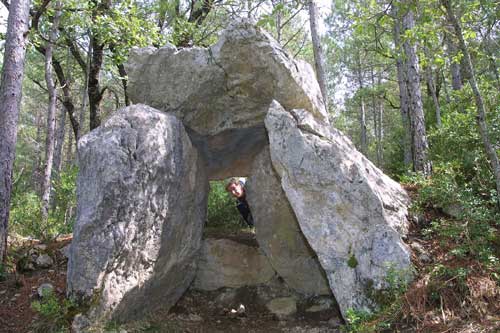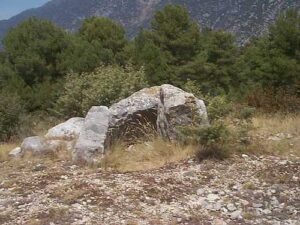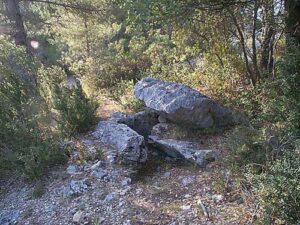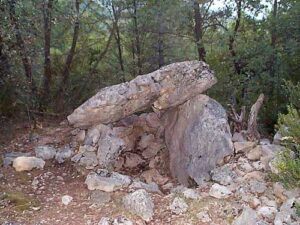
The Dolmen Route
This route begins at Organyà (Spain), which can be reached from La Seu d'Urgell (Spain) by following the N-260 and C-14 towards Coll de Nargó. From Organyà, visitors should take the road that runs to the west, towards Cabó, and almost immediately turn off to the left for Montanissell. In front of them, they will then see the Santa Fe crag and on top of it, the hermitage of the same name.
Further along, it is necessary to take a track, branching off to the right, which leads to the top of a small hill. On the right, visitors will find the first of the seven megaliths, that they will see along the route; this is the dolmen of Serrat de les Cobertrades which is not very well conserved. From here, it is possible to enjoy a panoramic view of Organyà. The route then continues along a gentle track that runs between crops and woodland until there is a branch off to the right leading to the dolmen of Colomera(km 3), which is in the middle of an oak grove, some 50 metres away. This is the best conserved example in both the Cabó valley and L'Alt Urgell (Spain).
Further on, visitors will come to a turn off leading to the dolmen of El Serrat de Malpàs. It lies 100 metres away and is just off the track that goes off to the right: it is well sign-posted. The route then continues up the Oliva rise. It then heads westwards through a flatter, crop growing area, passing the Alt and Pomajor hillocks to the right. There is then a turn off that leads to Vilar: this optional route provides a short cut and a view of the dolmens of Pedracabana and Oliva, which the main route will reach later. The main itinerary continues along the track and crosses the screes of Boixadera and Les Maçanes before reaching Cabó. The route enters the village by the Senyús path, passing Cal Simon and Cal Bullich.Once at Cabó, visitors are recommended to take the path up to the left of the Romanesque hermitage of Sant Serni. After that they should head for the main square and see the monumental fountain dedicated to local girl Arnaldeta Caboet. They should then head west along a track that climbs up the side of Can Pui and passes the Carrabina mill and the remains of Favà, an important building dating from the 9th century. A little further on, visitors will find the Favà mill dolmen, which has been reconstructed. They will then come to the Caixa fountain, under some poplar trees; to get there, it is necessary to follow the track, cross the gully, go down to the left and take the first path off to the right. The path then disappears until visitors get back to Cabó, from where it continues along the road to Organyà.



